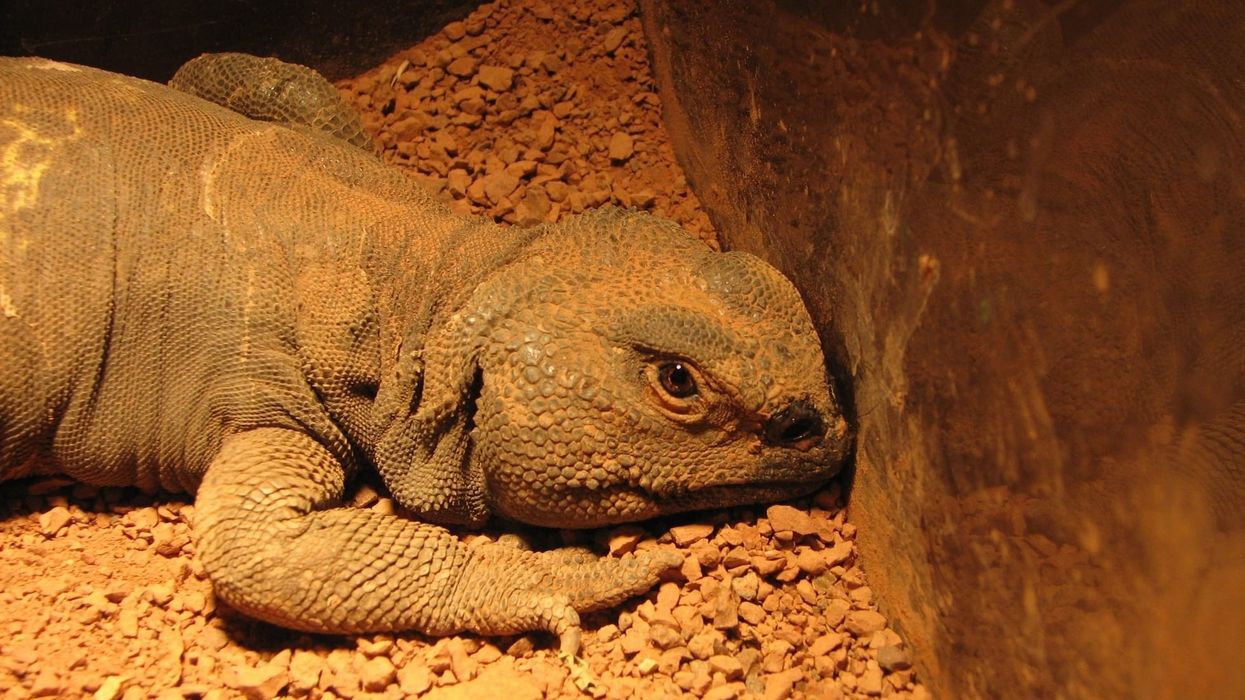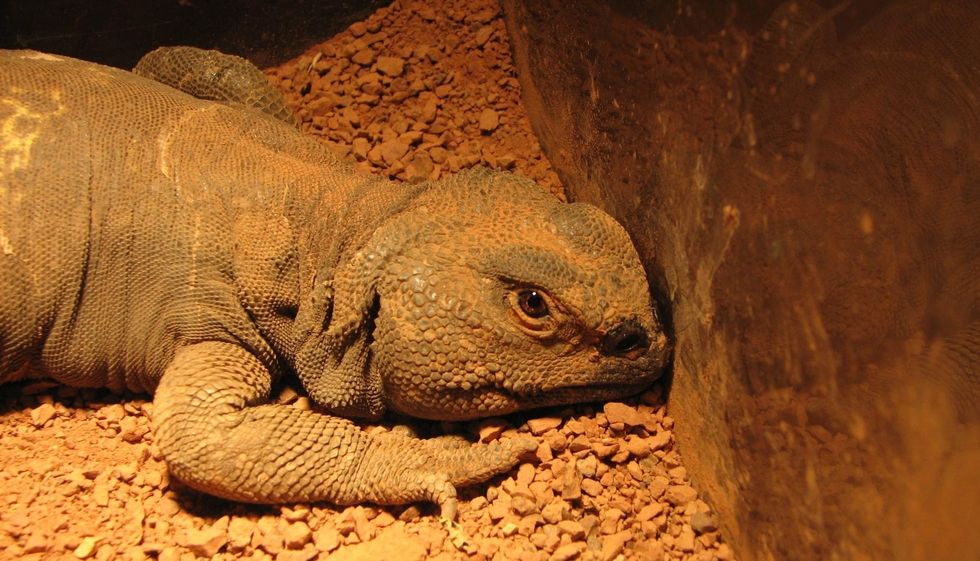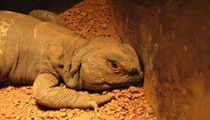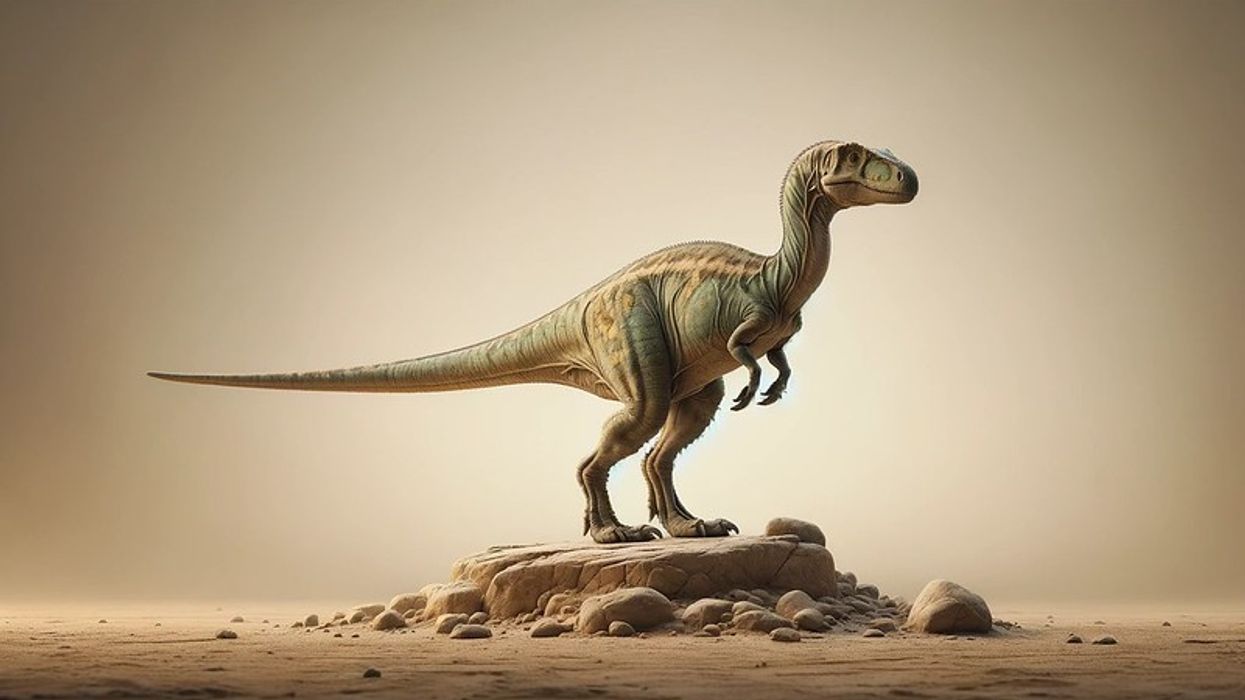Fun Uromastyx Facts For Kids

Content
- What type of animal is a Uromastyx?
- What class of animal does a Uromastyx belong to?
- How many Uromastyx are there in the world?
- Where does a Uromastyx live?
- What is a Uromastyx's habitat?
- Who does Uromastyx live with?
- How long does a Uromastyx live?
- How do they reproduce?
- What is their conservation status?
- What does Uromastyx look like?
- How cute are they?
- How do they communicate?
- How big is a Uromastyx?
- How fast can a Uromastyx move?
- How much does a Uromastyx weigh?
- What are the male and female names of the species?
- What would you call a baby Uromastyx?
- What do they eat?
- Are they poisonous?
- Would they make a good pet?
- Did you know...
- What are the different types of Uromastyx?
- Why is the Uromastyx endangered?
If you are looking for a unique species of lizard that is herbivorous and non-venomous, then you should read about the Uromastyx. Found in parts of northern Africa and the Middle East, these reptiles have been named due to their spiky tails.
The name 'uromastyx' comes from ancient Greek. The word 'uro' is derived from Greek for 'tail' while the term 'mastyx' has come from the Greek word for 'whip'.
Apart from their appropriate name, this lizard species is known for being a herbivore. They are usually docile and calm and this has led to an explosion of its popularity as a pet. Many people think of them as alternatives to the bearded dragons.
While there are a total of 15 species in the Uromastyx genus, there were three more lizard types included that were found in eastern Asia. However, they have since been classified under a different genus.
Keep on reading to learn more about the Uromastyx. If you want to read about other animals and reptiles, take a look at tuatara and leatherback sea turtle.
Uromastyx Interesting Facts
What type of animal is a Uromastyx?
The Uromastyx is a species or a genus of more than 12 spiny-tailed lizards that are mainly found in the continent of Africa. These reptiles are unique in the sense that they are primarily herbivorous and are quite popular in the pet trade.
Their names come from the feature of their spiny tails containing scales that is consistent throughout all the different species of Uromastyx.
What class of animal does a Uromastyx belong to?
The Uromastyx is a genus of spiny-tailed lizards that belongs to the class of Reptilia and family Agamidae. The Agamidae family of reptiles also includes similar lizards such as the bearded dragons and the Chinese water dragons.
Due to their similarities, bearded dragons are a great alternative for those looking to keep the various species of Uromastyx as pet lizards. Initially, this genus also included three more lizard types from Asia, but those three lizard types now have their genus called the Saara.
How many Uromastyx are there in the world?
Because there are more than a dozen different types of lizards classed under the Uromastyx genus, the total population of these lizard species cannot be estimated. However, while some types of Uromastyx are in no danger of population decline, some species have seen a significant decrease in population.
Initially, their falling numbers were due to the lack of information available about their diet and behavior related to water, temperatures, light, and burrows. As a result, most Uromastyx that were usually kept in captivity would die rather quickly. However, now pet Uromastyx care has improved due to there being more information present.
Where does a Uromastyx live?
Uromastyx lizards are known to live in the desert and rocky climates of Africa and parts of the Middle East. They are found in countries that are a part of the Sahara Desert like Egypt, Mali, and Morocco.
They are also common in Middle East countries like Saudi Arabia where consuming an Uromastyx lizard is an important part of their cultural diet. Species native to the country of Yemen have also been found.
What is a Uromastyx's habitat?
The Uromastyx habitat is closely related to the conditions and temperatures of a desert-type climate. They are known to survive in wild temperatures that are around 120 F (49 C).
It is safe to say that they can adapt to high temperatures, heat, and humidity in the wild. This temperature factor is important as these lizards are known for basking in the sun and heat all day to raise their body temperature.
However, deserts lose the heat during the night when temperatures fall sharply. However, this does not deter the Uromastyx who preserve their body heat from falling temperatures by staying in their burrow.
All the lizards of this genus make for great borrowers and have burrows that they make in the sand. These burrows are places where they live and hide when they feel they are in some sort of danger.
In regards to humidity, the ideal range for this lizard species is around 10% to 30%. They do not do too well when the humidity level is above 45%.
This reptile is mainly a terrestrial lizard who will primarily prefers to stay on the ground or near the ground. However, young Uromastyx lizards are partly arboreal i.e., they climb up on trees, branches, and platforms.
This arboreal behavior remains in some types of these lizards throughout their lives.
Unlike most reptile pets, this spiny-tailed lizard is diurnal and is not active during the night due to the drop in temperature in the Saharan wild. Some of these lizards have also been observed to hibernate for around two to five months when the temperature drops in the winter months.
Who does Uromastyx live with?
An Uromastyx lizard is generally a solitary reptile that is quite territorial in the wild. Yet, there have been instances of these reptiles living quite well in groups. Males are known to show aggression toward other males and reptiles that invade their territories. Also, young hatchlings are known to stay with their mothers for a while.
How long does a Uromastyx live?
A Uromastyx's life span in the wild is still relatively unknown due to the lack of information available on this species, though certain assumptions can be made from observations while in captivity.
These reptiles have been seen to live for between 30 to 35 years when given the proper care through suitable temperature, food and diet, water, and light needs.
On average, Uromastyxs are thought to live for 10 to 15 years in the wild.
They might reach their full size faster in captivity than in the wild. It usually takes uro reptiles around three to four years to reach their full size. It has been suggested that the larger the lizard, the longer it is supposed to live.
How do they reproduce?
Males of this species of reptiles are known to court females while basking in the heat. Courtship rituals include pushups and a display of strength.
Females are also chased in some instances by the male during the period of courtship. During this period, males can be very violent towards other males.
Sometimes, females are likely to flip around as a means of saying that it is not ready for breeding. In those cases, a desperate male may bite and cling to the neck of the female.
They may position themselves on top of females and wriggle its tail until they can mate. The mating goes for any period between two and 10 minutes and can be violent to look at.
Once the mating is successful, the gestation period for female animals is an average of four to six weeks. The litter size can vary from four to 40 eggs depending on the species and the size.
Once the eggs are laid, the incubation period for these eggs can stretch to 70 days. After the process of egg-laying, female reptiles of this species get dehydrated and lose weight.
This is one of the only times when the Uromastyx can be seen drinking a lot of water. Females return to good health within two weeks of egg-laying.
What is their conservation status?
Many of the lizards in this species haven't been evaluated by the International Union For Conservation Of Nature. However, a few species have been listed on the IUCN Red List ranging within the categories of Least Concern and Vulnerable.
The Schmidt's spiny-tailed lizard that is found in Algeria and Libya has been classified as Near Threatened. The ocellated Uromastyx endemic to northeastern Africa and the ornate mastigure from the Middle East have been termed as Least Concern. Unfortunately, the Egyptian Uromastyx has been classed as Vulnerable by the IUCN.
Uromastyx Fun Facts
What does Uromastyx look like?
After gaining popularity in recent years as a pet, interest in different types of Uromastyx lizards has grown. The most important physical feature of this genus is the spiny tail which is common in all the animals in this genus.
The spiny tail can be small or long depending on the species. These spiny tails have spikes on them in 10 to 30 rings.
Used as a defense against predators, a Uromastyx lizard can often be found resting in its burrow with its spiny tail close to the opening.
This acts as a deterrent to any animals or reptiles looking to hunt these reptiles for food. This lizard species also have blunt teeth as a result of which their bites aren't too dangerous.
Apart from this, there are certain differences in the skin color of Uromastyx lizards.
Uromastyx are known to have darker pigmentation on their skin which helps them to directly absorb more sunshine while basking in the sun. In a trait that is similar to other reptilian beings, the color of this lizard is known to alter with a change in temperature or heat when they are basking during the day.
The cool temperature in the desert leads to the Uromastyx having a dull color, while in a warm humidity-filled desert temperature, they appear to be more light and bright in appearance.
Some of these lizards have unique appearances. The Moroccan Uromastyx is known for its red and orange spots on the skin which is primarily black.
The Mali Uromastyx shows a difference in color between the genders, males are more jet black with yellowish markings while females have a more brownish or tan coloration.
The ornate Uromastyx, which is the most common as a pet, have males who are either blue, bright green, or red on occasion along with yellowish-brown patterns on their back. Females are less colorful in most instances of the Uromastyx.
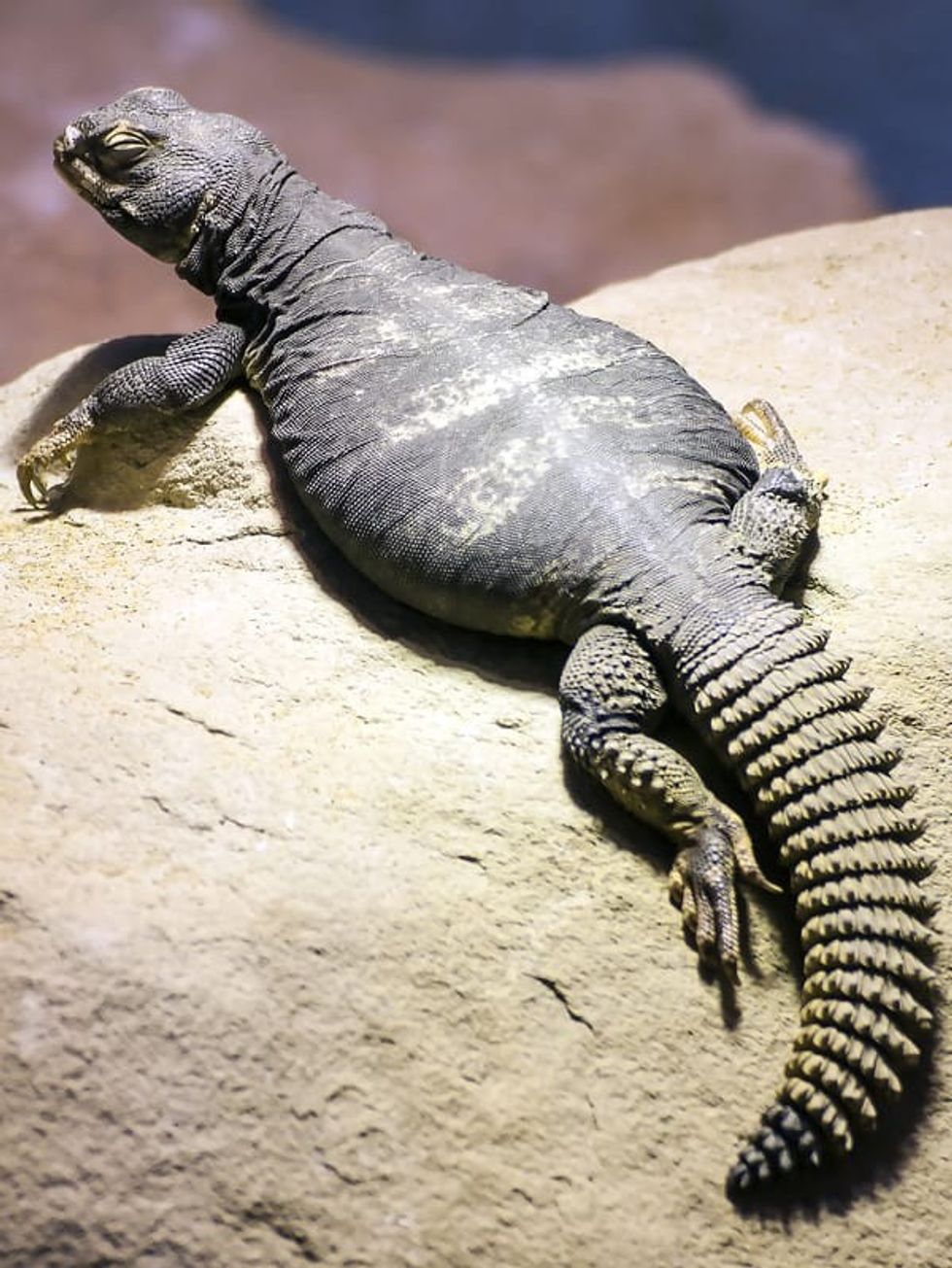
How cute are they?
Due to their physical appearance and laid-back lifestyle, many find the Uromastyx to be very cute. What also piques the interest of people is their food and dietary habits as they are primarily herbivorous and feed on various types of greens and plants.
Uromastyx babies are also found to be very cute. The spiny tail can be a feature of attraction with many finding the different skin coloration to be adorable.
How do they communicate?
Despite evidence of physical motions and actions as part of the Uromastyx communication mode, very little is known about how this species communicates with one another. There are certain courtship rituals along with the fact that these lizards mark their territory by the secretion of their glands.
They also intimidate their predators by using the feature of their spiny tails.
How big is a Uromastyx?
A Uromastyx length can be anywhere between 10-36 in (25-91 cm). An Egyptian spiny-tailed lizard grows to be around 3 ft (36 in).
The average length of a spiny-tailed lizard across the genus is between 10-18 in (25.4-46 cm). In comparison, the average bearded dragon is slightly bigger with a length of 16-24 in (41-61 cm). However, other lizards like Komodo dragons are around six to seven times bigger than Uromastyx.
How fast can a Uromastyx move?
Being small in size and adapted to desert habitats, an Uromastyx can move across rocks and crevices swiftly when it wants to. Unfortunately, due to a lack of conclusive data about this genus, no specific speed can be estimated.
How much does a Uromastyx weigh?
The weight of a Uromastyx varies between 3.2-32 oz (99-907 g). The average weight is around 15 oz (425 g) with bigger lizards in this species like the Egyptian lizard measuring near the higher end of the weight spectrum. A young hatched baby Uromastyx weighs 0.14-0.21 oz (4-6 g).
What are the male and female names of the species?
There are no distinct names for the males and females of this species.
What would you call a baby Uromastyx?
A baby Uromastyx doesn't have a distinct name. They are simply called hatchlings or baby Uromastyx lizards.
What do they eat?
Uromastyx lizards are primarily herbivores regarding their food diet. They can easily survive on greens and plants.
They are also known to eat desert plants like cacti and flowers like dandelion greens. While being held in captivity, normal leafy greens with other vegetables should make up their food diet.
In taking care of a Uromastyx diet, one must keep in mind that some leafy greens have no nutritional value and must be avoided. Although young Uromastyx lizards may consume insects to gain protein, most adults will never eat insects and only survive on a diet based on vegetation.
Most of their water intake comes from the vegetation in their diet. However, young ones and recent mothers have been observed to drink lots of water.
Are they poisonous?
No, Uromastx lizards are not poisonous at all even though they do tend to bite.
Would they make a good pet?
These lizards have become popular in recent years as a pet. However, while as a pet they are quite docile and calm, proper Uromastyx care should be given at all times about their diet, light, and temperature needs.
Uros need a tank of around 30-40 gal (136-182 l) to survive properly.
The substrate material should be properly taken care of as this lizard species love to dig burrows underground. An adequate amount of light should also be in the enclosure as the Uros need UV-A and UV-B light to live properly.
As a pet, they might take some time to get used to you handling them but they will readily allow you to handle them once habituated. They are quite friendly but it is not advisable to put different Uros together in a single enclosure.
Did you know...
Urosmastyx lizards are known to conserve water very well. As a result, these lizards excrete mineral salts from a gland that is situated near their nose.
A young lizard of this genus will often consume the feces of its mother as its first food meal.
Like other lizards, this lizard species cannot lose its tail at will.
What are the different types of Uromastyx?
The different types of Uromastyx lizards that fall under this genus include Uromastyx acanthinura, Uromastyx aegyptia, Uromastyx benti, Uromastyx ocellata, Uromastyx geyri, Uromastyx macfadyeni, Uromastyx alfredschmidti, Uromastyx dispar, Uromastyx nigriventris, Uromastyx occidentalis, Uromastyx ornata, Uromastyx shobraki, Uromastyx princess, Uromastyx yemenensis, and the Uromastyx thomasi. In total, there are 15 species listed under the genus of Uromastyx.
Why is the Uromastyx endangered?
The Egyptian spiny-tail lizard is the one species that is endangered. This is due to years of hunting by the Bedouin people in Egypt who have used this large lizard as a rich source of protein. They were also hunted as the strong skin of this lizard species makes for excellent leather.
Here at Kidadl, we have carefully created lots of interesting family-friendly animal facts for everyone to discover! Learn more about some other reptiles including thorny devil, or gila monster.
You can even occupy yourself at home by drawing one on our Uromastyx coloring pages.
We Want Your Photos!
More for You
Bachelor of Arts specializing in Journalism and Mass Communication, Postgraduate Diploma in Sports Management

Moumita DuttaBachelor of Arts specializing in Journalism and Mass Communication, Postgraduate Diploma in Sports Management
A content writer and editor with a passion for sports, Moumita has honed her skills in producing compelling match reports and stories about sporting heroes. She holds a degree in Journalism and Mass Communication from the Indian Institute of Social Welfare and Business Management, Calcutta University, alongside a postgraduate diploma in Sports Management.
Bachelor of Law

Abdulqudus MojeedBachelor of Law
A versatile professional with a passion for creative writing and technology. Abdulqudus is currently pursuing his Bachelor of Law from the University of Lagos and has experience as a tutor, intern assistant, and volunteer. He possesses strong organizational skills and is a detail-oriented person.
Disclaimer
1) Kidadl is independent and to make our service free to you the reader we are supported by advertising. We hope you love our recommendations for products and services! What we suggest is selected independently by the Kidadl team. If you purchase using the Buy Now button we may earn a small commission. This does not influence our choices. Prices are correct and items are available at the time the article was published but we cannot guarantee that on the time of reading. Please note that Kidadl is a participant in the Amazon Services LLC Associates Program, an affiliate advertising program designed to provide a means for sites to earn advertising fees by advertising and linking to Amazon. We also link to other websites, but are not responsible for their content.
2) At Kidadl, we strive to recommend the very best activities and events. We will always aim to give you accurate information at the date of publication - however, information does change, so it’s important you do your own research, double-check and make the decision that is right for your family. We recognise that not all activities and ideas are appropriate for all children and families or in all circumstances. Our recommended activities are based on age but these are a guide. We recommend that these ideas are used as inspiration, that ideas are undertaken with appropriate adult supervision, and that each adult uses their own discretion and knowledge of their children to consider the safety and suitability. Kidadl cannot accept liability for the execution of these ideas, and parental supervision is advised at all times, as safety is paramount. Anyone using the information provided by Kidadl does so at their own risk and we can not accept liability if things go wrong.
3) Because we are an educational resource, we have quotes and facts about a range of historical and modern figures. We do not endorse the actions of or rhetoric of all the people included in these collections, but we think they are important for growing minds to learn about under the guidance of parents or guardians.
